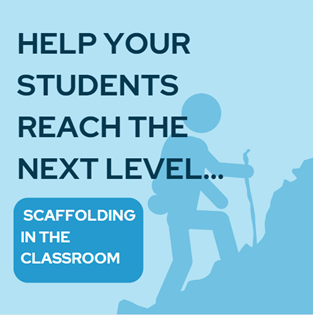Help your students reach the next level - Scaffolding in the classroom
A free professional blog to support English teachers

Understanding how to effectively support each and every student in our classroom is crucial to becoming a successful teacher and effective scaffolding techniques are the building blocks on which this support is built.
As a teacher, we are sure that you are very aware of how each of your students learn and that some may require more support when it comes to learning new material than others. This is where effective scaffolding strategies come into play. Scaffolding in the classroom may be a term you came across during your teacher training or perhaps this concept is entirely new. Let's dive into the basics so you can learn how to support each of your students in their learning.
- What is scaffolding in the classroom?
- How to use scaffolding in your lessons
- Why should you use scaffolding in your classroom?
What is scaffolding in the classroom?
Learning is a complicated process and so anything we can do to make this more manageable and less overwhelming for our students the better. Scaffold learning refers to the process of supporting students in order to help them reach a goal or complete a task, much like the way in which the scaffolding on a construction site allows the workers to climb to the next level and complete their tasks in a safe and structured manner. During scaffold learning the teacher will break down tasks into smaller more manageable chunks and offer support along the way to those students who need it while also allowing students to think independently.
How to use scaffolding in your lessons
Now we know what scaffold learning is, how do we incorporate it into our lessons? The aim with scaffold learning is to break your lessons down into bite-size chunks. Happily, this structure is also beneficial for teachers too because you have a detailed plan that you can stick to.
Within each “chunk” of the lesson you can begin to incorporate different scaffolding strategies. You’ll find some examples of these below:
Pre-teach vocabulary
This strategy is particularly helpful for students who are learning a new language. If you are moving on to a new subject, teach your students new words that they might encounter ahead of time. This allows them to engage with the subject matter with a deeper level of understanding.
Modelling behaviour
Many students learn better by seeing something rather than reading or hearing about it so show your students how to complete a task before they have a chance to try it for themselves.
Allow time to talk
We all need time to process new information so allow your students space and time to discuss what they are learning and ask questions. This allows them to problem solve and process out loud with their peers. Maintain some structure during these discussions by splitting your students into smaller groups. They can then come together and share their thoughts with the group as a whole later.
Give feedback
Feedback is a very important part of the learning process. This allows you to let your students know what they are doing well and what they need to work on. It also helps your students feel secure that you are paying attention to what they are doing. When giving them feedback, be specific, helpful, and encouraging.
Why should you use scaffold learning in your classroom?
Scaffold learning is helpful for students of all ages and levels. It builds confidence and encourages independence in students of all abilities, whether your students are struggling or quick learners, they can all benefit from scaffold learning.
Scaffold learning provides support where it is needed and encourages students to think critically about their work and the outcomes. Students are able to overcome challenges and master new concepts in their own time when tasks are broken down for them into smaller sections. Incorporate scaffold learning into your lessons and discover the benefits for yourself.
Read more blog posts from The English Classroom here and be sure to sign up for our English teaching resources here. We will also send blog posts direct to your email.
Written by Rebecca Sparling